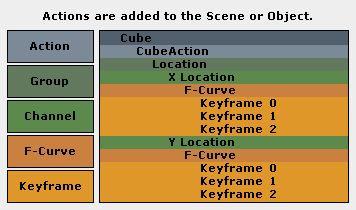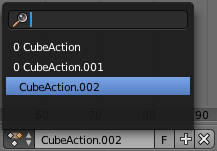Actions¶
When animating objects and properties in Blender, Actions record and contain the data. As everything else in Blender, Actions are data-blocks.

Actions.
So when you animate an object by changing its location with keyframes, the animation is saved to the Action.
Each property has a channel which it is recorded to, for example, Cube.location.x is recorded to Channel X Location. The X location and Y location properties can be shared across multiple objects, if both objects have X location and Y location properties beneath them.

Graph Editor. Each Channel has an F-Curve represented by the lines between the keyframes.
- Actions
- Record and contain animation data.
- Groups
- Are groups of channels.
- Channels
- Record properties.
- F-Curves
- F-Curve are used to interpolate the difference between the keyframes.
- Keyframes
- Keyframes are used to set the values of properties bound to a point in time.
Working with Actions¶

The Action data-block menu.
When you first animate an object by adding keyframes, Blender creates an Action to record the data.
Actions can be managed with the Action data-block menu in the Dope Sheet Action Editor header, or the properties region of the NLA Editor.
If you are making multiple actions for the same object, press the F button for each action, this will give the actions a Fake User and will make Blender save the unlinked actions.
Objects can only use one Action at a time for editing, the NLA Editor is used to blend multiple actions together.
Bake Action¶
Reference
The Bake Action tool will apply interpolated frames into individual key frames.
This can be useful for adding deviation to a cyclic action like a walk cycle. This can also useful for keyframe animations created from drivers or constraints.